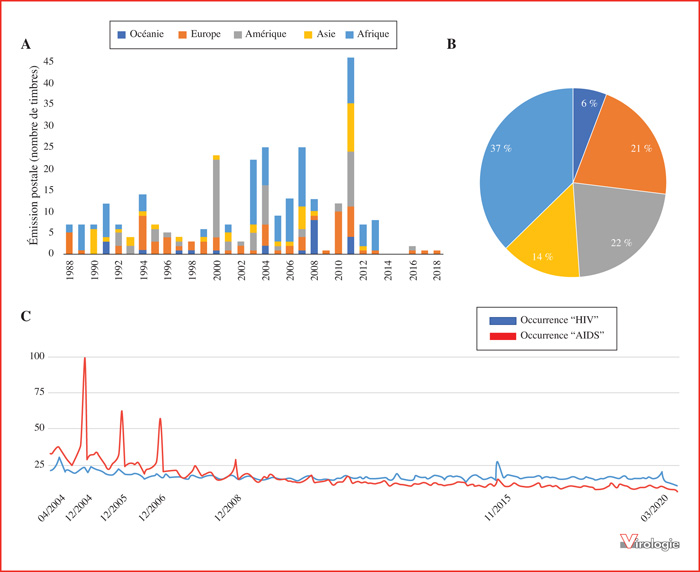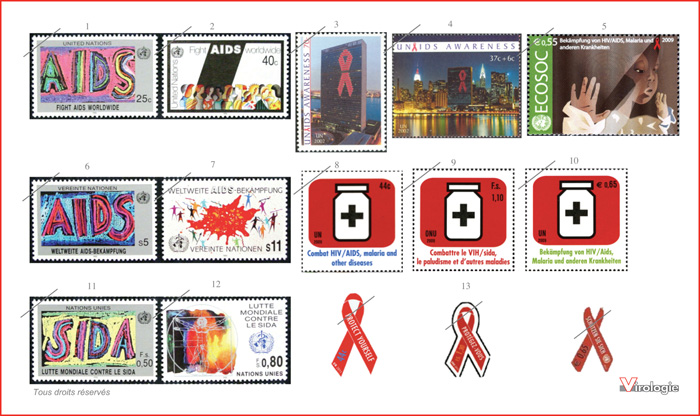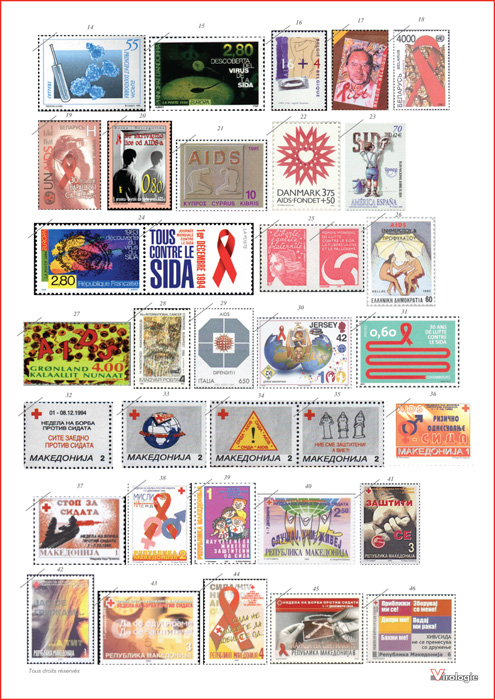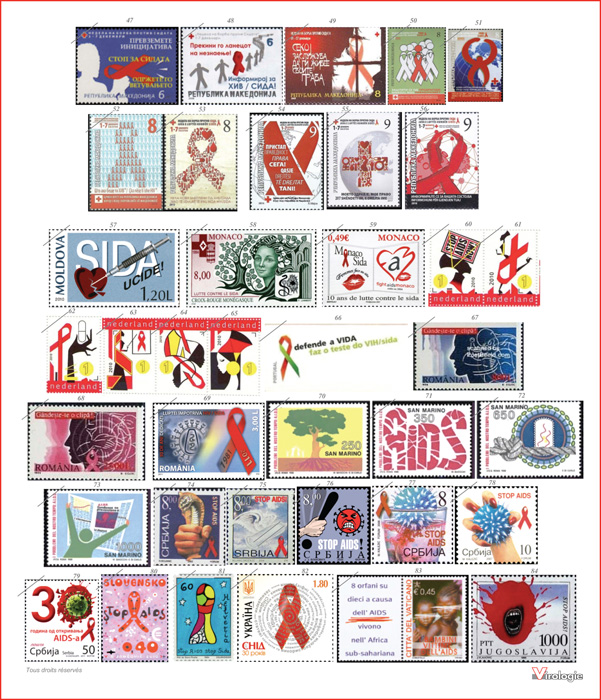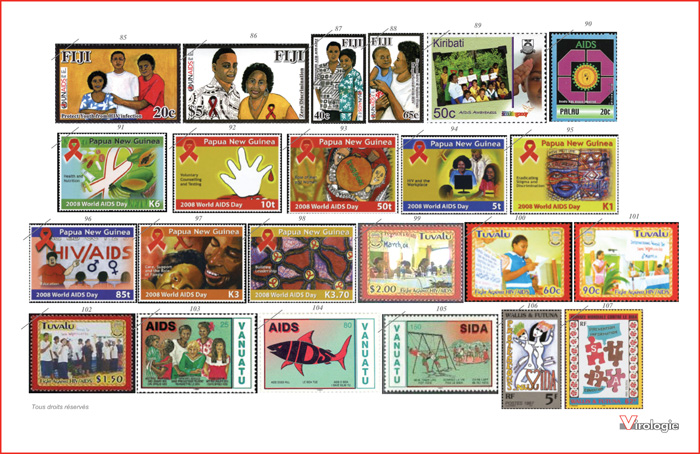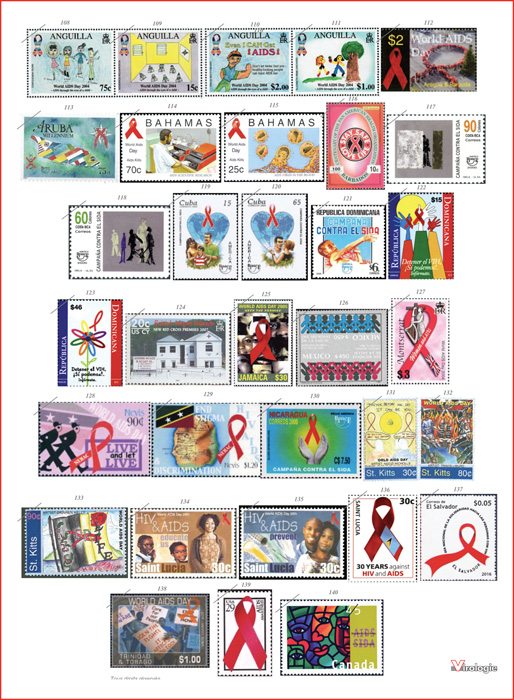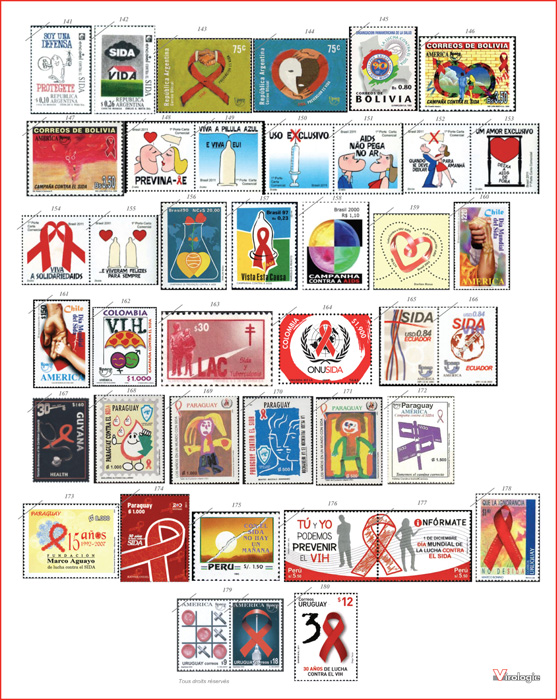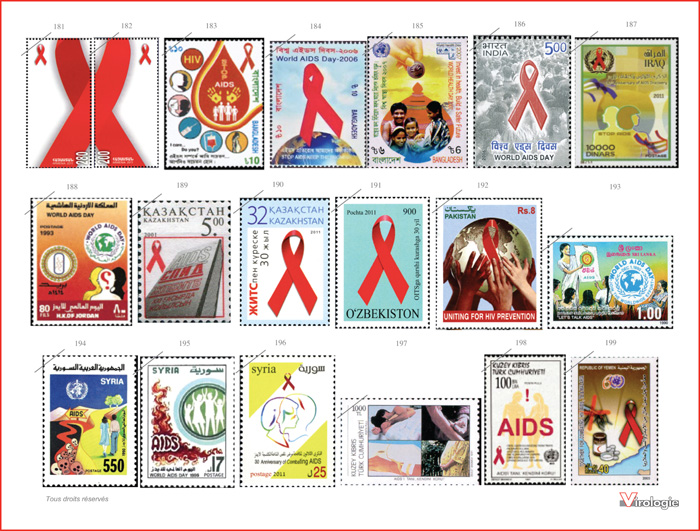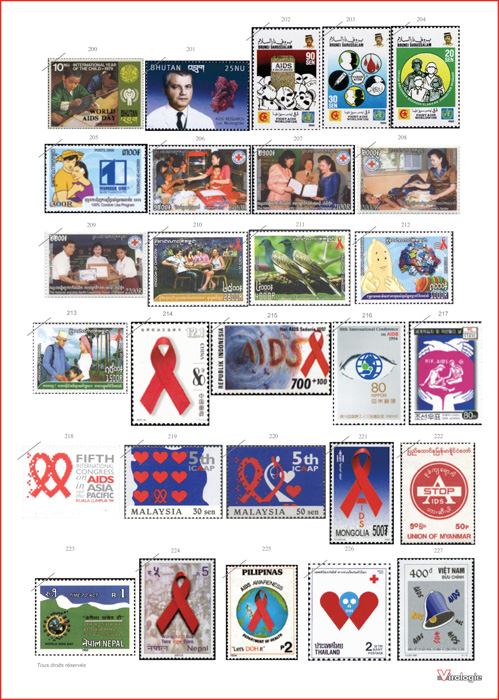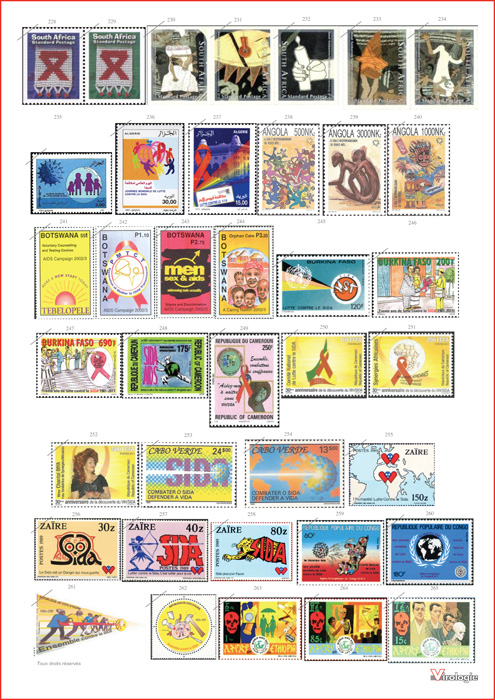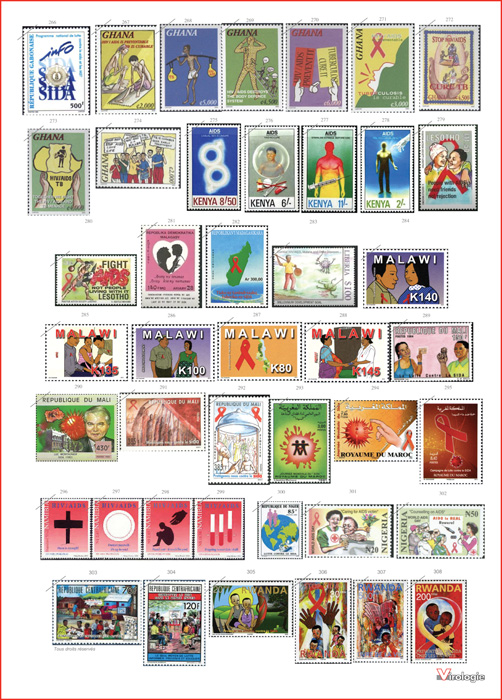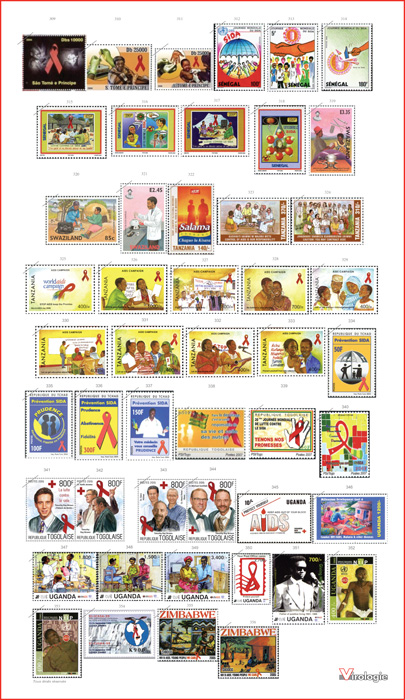Figures
Figure 1
A, B. Émission postale annuelle dédiée au VIH et contribution par continent. C. Fréquence de saisie sur Google des termes « HIV » (bleu), et « AIDS » dans le monde depuis 2004 (par Google Trends).
Figure 1
Figure 2
Timbres émis par les Nations unies. Numéros 1-13 (1990, 1990, 2002, 2002, 2009, 1990, 1990, 2009, 2009, 2009, 2009, 2011, 2011, 2011). Les hachures visent à annuler la valeur fiduciaire du timbre.
Figure 2
Figure 3
Timbres émis en Europe (I). Numéros 14-15 : Andorre (1994). 16-17 : Belgique (1995, 2004). 18 : Biélorussie (1997, 2011). 19-20 : Bosnie (2000, 2011). 21 : Chypre (1995). 22 : Danemark (1996). 23 : Espagne (2000). 24-25 : France (1996, 2004). 26 : Grèce (1992). 27 : Groenland (1992). 28 : Hongrie (1992). 29 : Italie (1989). 30 : Jersey (2010). 31 : Luxembourg (2011). 32-46 : Macédoine (1994, 1994, 1994, 1994, 1995, 1996, 1998, 1998, 1999).
Figure 3
Figure 4
Timbres émis en Europe (II). Numéros 47-56 : Macédoine (2000, 2001, 2002, 2003, 2004, 2006, 2007, 2008, 2009, 2010, 2011, 2012, 2013, 2016, 2017, 2018). 57 : Moldavie (2010). 58-59 : Monaco (1994, 2007). 60-65 : Pays-Bas (2010). 66 : Portugal (?). 67-69 : Roumanie (1999, 1999, 2011). 70-73 : Saint-Martin (1988). 74-79 : Serbie (2002, 2004, 2005, 2006, 2007, 2011). 80 : Slovénie (2010). 81 : Suisse (1994). 82 : Ukraine, (2011). 83 : Vatican (2004). 84 : Yougoslavie (1988). .
Figure 4
Figure 5
Timbres émis en Océanie. Numéros 85-88 : Fidji (2011). 89 : Kiribati (2007). 90 : Palau (2000). 91-98 : Papouasie (2008). 99-102 : Tuvalu (2004). 103-105 : Vanuatu (1991). 106-107 : Wallis (1997, 1998).
Figure 5
Figure 6
Timbres émis en Amérique du Nord et centrale. Numéros 108 110 : Anguilla (2004). 112 : Antigua-et-Barbuda (2004). 113 : Aruba (2000). 114-115 : Bahamas (1995). 116 : Barbuda (2002). 117-118 : Costa Rica (2000). 119-120 : Cuba (2000). 121-123 : République Dominicaine (2000, 2010). 124 : Îles Vierges Britanniques. 125 : Jamaïque (2005). 126 : Mexique (?). 127 : Montserrat (2004). 128-129 : Niévès (2003). 130 : Nicaragua (2000). 131-133 : Saint Christophe (2004). 134-136 : Sainte Lucie (2004, 2001). 137 : Salvador (2016). 138 : Trinité-et-Tobago (2003). 139 : États-Unis d’Amérique (2003). 140 : Canada (1996).
Figure 6
Figure 7
Timbres émis en Amérique du Sud. Numéros 141 144 : Argentine (1992, 1992, 2000, 2000). 145-147 : Bolivie (1993, 2000, 2000). 148-159 : Brésil (2011, 2011, 2011, 2011, 2011, 2011, 2011, 2011, ?, ?, 2000, 2003). 160-161 : Chili (2000, 2000). 162-164 : Colombie (2000, ?, 2011). 165-166 : Équateur (2001, 2011). 167 : Guyane (?). 168-174 : Paraguay (1995, 1997, ?, 2000, 2007, 2011). 175-177 : Pérou (1993, ?). 178-180 : Uruguay (1993, 2000, 2001, 2011).
Figure 7
Figure 8
Timbres émis en Moyen-Orient, Inde. Numéros 181 182 : Arménie (2011). 183-185 : Bangladesh (2006, 2007). 186 : Inde (2006). 187 : Iraq (2001). 188 : Jordanie (1993). 189-190 : Kazakhstan (2001, 2011). 191 : Ouzbékistan (2011). 192 : Pakistan (2011). 193 : Sri-Lanka (1990). 194-196 : Syrie (1990, 1995, 2011). 197-198 : Turquie (1991, ?). 199 : Yémen (2005).
Figure 8
Figure 9
Timbres émis en Extrême-Orient. Numéros 200 201 : Bouthan (1988, 2000). 202-204 : Brunei (1990). 205-213 : Cambodge (2005, 2007, 2007, 2007, 2007, 2011, 2011, 2011, 2011). 214 : Chine (2003). 215 : Indonésie (?). 216 : Japon (1994). 217 : Corée (du Nord) (2003). 218-220 : Malaisie (1999, ?, ?). 221 : Mongolie (2008). 222 : Myanmar (1992). 223-224 : Népal (1993, 2012). 225 : Philippines (1994). 226 : Thaïlande (1990). 227 : Vietnam (1997).
Figure 9
Figure 10
Timbres émis en Afrique (I). Numéros 228 234 : Afrique du Sud (2013). 235-237 : Algérie (2005, 2011). 238-240 : Angola (1994). 241-244 : Botswana (2003). 245-247 : Burkina-Faso (1989). 248-252 : Cameroun (2011). 253-254 : Cap-Vert (1991, 1992). 255-260 : Zaïre/Congo (1988, 1989, 1990, 1991, 1988). 261-262 : Côte d’Ivoire (2003, 2004). 263-265 : Éthiopie (1991).
Figure 10
Figure 11
Timbres émis en Afrique (II). Numéros 266 : Gabon (?); 267-274 : Ghana (2006). 275-278 : Kenya (?, 1991). 279-280 : Lesotho (?). 281-282 : Madagascar (1991, 2005). 283 : Libéria (?). 284-288 : Malawi (2012). 289-292 : Mali (1994, 1999, 2001). 293-295 : Maroc (1991, 2006, 2011). 296-299 : Namibie (?). 300 : Niger (1989). 301-302 : Nigéria (2003). 303-304 : République Centrafricaine. 305-308 : Rwanda (2003).
Figure 11
Figure 12
Timbres émis en Afrique (III). Numéros 309 311 : Sao Tomé (2004, 2008). 312-318 : Sénégal (1989, 2004, 2005). 319-321 : Swaziland (2003). 322-333 : Tanzanie (2007, 2008). 334-337 : Tchad (2004). 338-344 : Togo (2007, 2019). 345-353 : Ouganda (2003, 2005, 2011, ?). 354 : Zambie (1999). 355, 356 : Zimbabwe (2005, 2006).
Figure 12
Authors
1 Assistance publique des Hôpitaux de Paris, AP-HP, France
2 Université de Paris, UTCBS, CNRS-Inserm, Paris, France
3 Service de virologie, Hôpital universitaire Bichat-Claude Bernard, AP-HP, Paris, France
4 Université de Paris, IAME, Inserm, Paris, France
5 Professeur honoraire, Paris, France
The postage stamp can serve as a means of promoting the social, educational and philanthropic aspects of the fight against disease in general and infectious diseases (such as AIDS, associated with HIV infection) in particular. The recent but eventful history of this virus and the disease that it causes has prompted the issue of a considerable number of postage stamps worldwide – barely fewer than the number dedicated to combating tuberculosis and malaria. The present semiotic review of 356 international postage stamps on HIV/AIDS is the first to have used a multicriterion evaluation grid based on the interpretation of indices , icons , and symbols . The stereotypes and the most novel representations and the messages conveyed on the cultural and ideological levels are thus characterized with regard to the disease's historical, scientific and epidemiological context. This analysis concludes with a humanist plea as an illustration of Hippocratic and Galenic values: prevention, education, solidarity, empathy, healthcare, and research.


